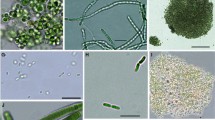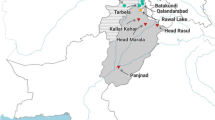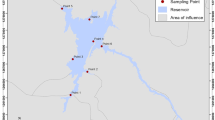Abstract
The toxic cyanobacterial communities of four recreational reservoirs (Bueng Kaen Nakhon, Bueng Thung Sang, Bueng Nong Khot, and Bueng See Than) in Amphur Muang, Khon Kaen Province, Thailand, were investigated. Water samples were collected via monthly sampling from June to October 2011 for the study on the diversity and density of toxic cyanobacteria and toxin quantification. The main toxic cyanobacteria present in these reservoirs were Aphanocapsa sp., Cylindrospermopsis sp., Leptolyngbya sp., Limnothrix sp., Microcystis sp., Oscillatoria sp., Planktolyngbya sp., Planktotrix sp., and Pseudanabaena sp. The dominant bloom-forming genera in the water samples from Bueng Nong Khot and Bueng See Than were Microcystis sp. and Cylindrospermopsis sp., respectively. Enzyme-linked immunosorbent assays specific for cyanotoxins were performed to detect and quantify microcystins and cylindrospermopsins, with the highest average microcystins content (0.913 μgL−1) being found in the sample collected from Bueng Nong Khot and the highest average cylindrospermopsins content (0.463 μgL−1) being found in the sample collected from Bueng See Than. The application of 16S rRNA analyses to cyanobacterial isolates BKN2, BNK1, BNK2, and BST1 indicated that these isolates are most closely related to Limnothrix planctonica (JQ004026) (98 % similarity), Leptolyngbya sp. (FM177494) (99 % similarity), Microcystis aeruginosa (DQ887510) (99 % similarity), and Limnothrix redekei (FM177493) (99 % similarity), respectively.




Similar content being viewed by others
References
Bolch, C. J. S., & Blackburn, S. I. (1996). Isolation and purification of Australian isolates of the toxic cyanobacterium Microcystis aeruginosa Kütz. Journal of Applied Phycology, 8(1), 5–13.
Bormans, M., Ford, P. W., & Fabbro, L. (2005). Spatial and temporal variability in cyanobacterial populations controlled by physical processes. Journal of Plankton Research, 27(1), 61–70.
Bradt, S., & Villena, M. J. (2002). Detection of microcystins in the coastal lagoon La Albufera de Valencia, Spain by an enzyme-linked immunosorbent assay (E.L.I.S.A.). Limnetica, 20(2), 187–196.
Chapman, A. D., & Schelske, C. L. (1997). Recent appearance of Cylindrospermopsis (cyanobacteria) in five hypereutrophic Florida Lake. Journal of Phycology, 33(2), 191–195.
Doyle, J. J., & Doyle, J. L. (1990). Isolation of plant DNA from fresh tissue. Focus, 12(1), 13–15.
Duy, T. N., Lam, P. K. S., Shaw, G. R., & Connell, D. W. (2000). Toxicology and risk assessment of freshwater cyanobacterial (blue-green algal) toxins in water. Reviews of Environmental Contamination and Toxicology, 163, 113–186.
El-Shehawy, R., Gorokhova, E., Fernández-Piñas, F., & del Campo, F. F. (2012). Global warming and hepatotoxin production by cyanobacteria: what can we learn from experiments? Water Research, 46(5), 1420–1429.
Fastner, J., Heinze, R., Humpage, A. R., Mischke, U., Eaglesham, G. K., & Chorus, I. (2003). Cylindrospermopsin occurrence in two German lakes and preliminary assessment of toxicity and toxin production of Cylindrospermopsis raciborskii (cyanobacteria) isolates. Toxicon, 42(3), 313–321.
Ferrão-Filho, A. S., & Kozlowsky-Suzuki, B. (2011). Cyanotoxins: bioaccumulation and effects on aquatic animals. Marine Drugs, 9(12), 2729–2772.
Funari, E., & Testai, E. (2008). Human health risk assessment related to cyanotoxins exposure. Critical Reviews in Toxicology, 38(2), 97–125.
Furtado, A. L. F. F., Calijuri, M. C., Lorenzi, A. S., Honda, R. Y., Genuario, D. B., & Fiore, M. F. (2009). Morphological and molecular characterization of cyanobacterium from a Brazillian facultative wastewater stabilization pond and evaluation of microcystin production. Hydrobiologia, 627(1), 195–209.
Grabowska, M., & Pawlik-Skowrońska, B. (2008). Replacement of Chroococcales and Nostocales by Oscillatoriales caused a significant increase in microcystin concentrations in a dam reservoir. Oceanological and Hydrobiological Studies, 37(4), 23–33.
Hoshaw, R., & Rosowski, J. R. (1973). Method for microscopic algae. In J. R. Stein (Ed.), Handbook of phycological methods, culture methods and growth measurements (pp. 53–56). London: Cambridge University Press.
Jayatissa, L. P., Silva, E. I. L., McElhiney, J., & Lawton, L. A. (2006). Occurrence of toxigenic cyanobacterial blooms in freshwaters of Sri Lanka. Systematic and Applied Microbiology, 26(2), 156–164.
Jones, W. W., & Sauter, S. (2005). Office of water quality. Bloomington: Idiana University.
Kim, B. H., Sang, M., Hwang, S. J., & Han, M. S. (2008). In situ bacterial mitigation of the toxic cyanobacterium Microcystis aeruginosa: implications for biological bloom control. Limnology and Oceanography: Methods, 6, 513–522.
Komárek, J., & Anagnostidis, K. (2005). Cyanoprokaryota 2. Teil/2nd part: Oscillatoriales. In B. Büdel, G. Gärtner, L. Krienitz, & M. Schagerl (Eds.), Süsswasserflora von Mitteleuropa, Vol 19(2). (pp. 759). Heidelberg: Elsevier.
Liu, Y. M., Chen, W., Li, D. H., Huang, Z. B., Shen, Y. W., & Liu, Y. D. (2011). Cyanobacteria-/cyanotoxin-contaminations and eutrophication status before Wuxi drinking water crisis in Lake Taihu, China. Journal of Environmental Sciences, 23(4), 575–581.
Mahakhant, A., Seetachan, P., Limpanussorn, J., Tungtananuwat, M., Ratanachot, P., & Arunpairojana, V. (2001). Survey of toxicogenic cyanobacterial blooms in water sources in military bases of Thailand. In The 5th International Conference on Toxic Cyanobacteria, Queensland.
Mitsuhiro, Y., Takashi, Y., Yukari, T., Naohiko, H., & Shingo, H. (2007). Dynamics of microcystin-producing and non-microcystin-producing Microcystis populations is correlated with nitrate concentration in a Japanese lake. FEMS Microbiology Letters, 226(1), 49–53.
Mohamed, Z. A., & Al Shehri, A. M. (2010). Microcystin production in epiphytic cyanobacteria on submerged macrophytes. Toxicon, 55(7), 1346–1352.
Mur, L. R., Skulberg, O. M., & Utkilen, H. (1999). Cyanobacteria in the environment. In I. Chorus & J. Bartran (Eds.), Toxic cyanobacteria in water: a guide to their public health consequences, monitoring and management (pp. 15–40). London: E&FN Spon.
Paerl, H. W. (1996). Microscale physiological and ecological studies of aquatic cyanobacteria: macroscale implications. Microscopy Research and Technique, 33(1), 47–72.
Paerl, H. W., & Otten, T. G. (2013). Harmful cyanobacterial blooms: causes, consequences, and controls. Microbial Ecology. doi:10.1007/s00248-012-0159-y.
Paerl, H. W., & Paul, V. J. (2012). Climate change: links to global expansion of harmful cyanobacteria. Water Research, 46(5), 1349–1363.
Pearson, L. A., & Neilan, B. A. (2008). The molecular genetics of cyanobacterial toxicity as a basis for monitoring water quality and public health risk. Current Opinion in Biotechnology, 19(3), 281–288.
Peerapornpisal, Y., Sonthichai, W., Suchotiratana, M., Lipigorngoson, S., Ruangyuttikarn, W., Ruangrit, K., et al. (2002). Survey and monitoring of toxic cyanobacteria in water resources for water supplies and fisheries in Thailand. Chiang Mai Journal of Science, 29(2), 71–79.
Peerapornpisal, Y., Phalaraksh, C., Kunpradid, T., Pekkoh, J., & Nivasabutr, S. (2009). Survey and monitoring of water samples and aquatic animals in standing water. Chiang Mai: Chiang Mai University (in Thai).
Pongswat, S., Thammathaworn, S., Peerapornpisal, Y., Thanee, N., & Somsiri, C. (2004). Diversity of phytoplankton in the Rama IX Lake, a man-made lake, Pathumthani province, Thailand. Science Asia, 30(3), 261–267.
Pouría, S., de Andrade, A., Barbosa, J., Cavalcanti, R. L., Berreto, V. S. T., Ward, C. J., et al. (1998). Fatal microcystin intoxication in haemodialysis unit in Caruaru, Brazil. The Lancet, 352(1921), 21–26.
Rantala, A., Rajaniemi-Wacklin, P., Lyra, C., Lepisto, I., Rintala, J., Mankiewicz-Boczek, J., et al. (2006). Detection of microcystin-producing cyanobacteria in Finnish lakes with genus-specific microcystin synthetase gene E (mcyE) PCR and associations with environmental factors. Applied and Environmental Microbiology, 72(9), 6101–6110.
Richardson, L. L., Sekar, R., Myers, J. L., Gantar, M., Voss, J. D., Kaczmarsky, L., et al. (2007). The presence of the cyanobacterial toxin microcystin in black band disease of corals. FEMS Microbiology Letters, 272(2), 182–187.
Robarts, R. D., & Zohary, T. (1987). Temperature effects on photosynthetic capacity, respiration, and growth rates of bloom-forming cyanobacteria. New Zealand Journal of Marine Freshwater Research, 21(3), 391–399.
Saitou, N., & Nei, M. (1987). The neighbor-joining method: a new method for reconstructing phylogenetic trees. Molecular Biology and Evolution, 4(4), 406–425.
Sivonen, K., & Jones, G. (1999). Cyanobacterial toxins. In I. Chorus & J. Bartran (Eds.), Toxic cyanobacteria in water: a guide to their public health consequences, monitoring and management (pp. 41–111). London: E&FN Spon.
Spoof, L., Berg, K. A., Rapala, J., Lahti, K., Lepisto, L., Metcalf, J. S., et al. (2006). First observation of cylindrospermopsin in Anabaena lapponica isolated from the boreal environment (Finland). Environmental Toxicology, 21(6), 552–560.
Acknowledgements
The authors would like to thank Prof. Dr. Nison Sattayasai for his assistance with the genetic analysis and useful discussions. We are grateful to The Regional Environmental Office, The Ministry of Natural Resources and Environment of the Kingdom of Thailand, and the Environmental section of Khon Kaen Municipality, Khon Kaen, Thailand, for providing some physical and chemical water characteristics of the reservoirs. Financial support from the Faculty of Science, Khon Kaen University, Thailand, is also gratefully acknowledged.
Author information
Authors and Affiliations
Corresponding author
Rights and permissions
About this article
Cite this article
Somdee, T., Kaewsan, T. & Somdee, A. Monitoring toxic cyanobacteria and cyanotoxins (microcystins and cylindrospermopsins) in four recreational reservoirs (Khon Kaen, Thailand). Environ Monit Assess 185, 9521–9529 (2013). https://doi.org/10.1007/s10661-013-3270-8
Received:
Accepted:
Published:
Issue Date:
DOI: https://doi.org/10.1007/s10661-013-3270-8




